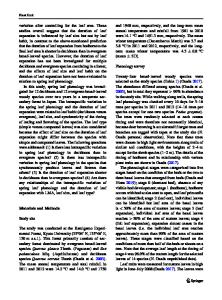Leaf hydraulic properties are decoupled from leaf area across coffee species
- PDF / 1,385,717 Bytes
- 8 Pages / 595.276 x 790.866 pts Page_size
- 3 Downloads / 284 Views
SHORT COMMUNICATION
Leaf hydraulic properties are decoupled from leaf area across coffee species Rafael Mauri1 · Amanda A. Cardoso1 · Mariela M. da Silva1 · Leonardo A. Oliveira1 · Rodrigo T. Avila1 · Samuel C. V. Martins1 · Fábio M. DaMatta1 Received: 14 February 2020 / Revised: 21 March 2020 / Accepted: 27 April 2020 © Springer-Verlag GmbH Germany, part of Springer Nature 2020
Abstract Changes in leaf size have been demonstrated to considerably affect leaf hydraulic properties, which in turn impact plant photosynthesis and productivity. In this study, we selected five genotypes from four coffee species (Coffea spp.) with highly contrasting individual leaf areas (from 25 to 280 cm2) to test whether changes in foliar area result in anatomical alterations and ultimately changes in leaf hydraulic function. Increasing leaf area was associated with xylem anatomical traits, such as lower major vein density, higher number of conduits and conduit diameter, and lower cell wall thickness-to-conduit diameter ratio [(t/b)3] in the midrib xylem. Such modifications, however, were not associated with changes in leaf hydraulic conductance (Kleaf) and resulted in minor, if at all, changes in the water potential causing 50% decline in Kleaf (P50), which demonstrate that leaves of coffee species have very similar hydraulic properties despite considerable variations in foliar area. We propose that declines in major vein density in larger coffee leaves are potentially balanced by increases in xylem conduit number and dimensions in the midrib, resulting in similar Kleaf when compared with smaller leaves. Finally, we demonstrate that C. racemosa plants have both the lowest P50 and the higher (t/b)3, and it should be considered as a putative candidate for breeders aiming at increasing drought tolerance in coffee plants. Keywords Coffea · Leaf hydraulic conductance · Hydraulic vulnerability · Vein density · Xylem structure
Introduction While stem hydraulic traits are closely related to droughtinduced mortality of plants (Choat et al. 2012, 2018; Adams et al. 2017; Hammond et al. 2019), leaf hydraulic properties have major impacts on plant photosynthesis and productivity Communicated by Andrea Nardini. Rafael Mauri and Amanda A. Cardoso contributed equally to this work. Electronic supplementary material The online version of this article (https://doi.org/10.1007/s00468-020-01983-y) contains supplementary material, which is available to authorized users. * Amanda A. Cardoso [email protected] * Fábio M. DaMatta [email protected] 1
Departamento de Biologia Vegetal, Universidade Federal de Viçosa, Viçosa, MG 36570‑900, Brazil
(Niklas 1999; Sack and Holbrook 2006; Brodribb et al. 2007). Leaf veins provide the hydraulic network to supply water to the stomata-bearing evaporating surfaces with a precise coordination between leaf vein density and stomata density (Carins Murphy et al. 2016; Zhang et al. 2018), so that reductions in leaf veins maintaining stomatal density result in lower photosynthetic rates due to lower lea
Data Loading...











